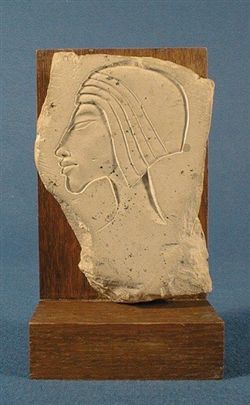
Although museums all over the world have numerous objects which may be called Egyptian art, almost all of these objects have been made by unknown artists. Only very seldom do we come across a reference to the name of the maker. Although the craftsmen remain anonymous, a great deal is known about how they went to work. After all, many tombs have depictions showing how many different objects were made. Often the entire production process is illustrated. Further, we also have the objects themselves, and close examination often reveals how they were made. In addition, we also know many of the tools they used, again as a result of archaeological finds or from illustrations. The depictions showing the manufacture of metal objects often show the melting of the metal; fire in ovens is fanned using bellows or blowpipes. The molten metal is poured into moulds made of stone or pottery, sometimes after first being mixed with other metals. The so-called "lost wax" technique was also often used, where the object was first made in wax, then covered with clay. When the clay was fired, the wax melted and you were left with a hollow mould, into which the metal could be poured. Not only statues were made in this way, but also weapons and tools. Further, metal was also hammered into shape using stone hammers. Gold leaf was made in this way. The representations showing the precise measuring of the metal or precious metal are particularly interesting - the weighing scales often have a figure of the goddess Maat, the goddess of truth, on them. The amount of metal issued was also recorded meticulously. Wooden objects were made from both indigenous and imported woods. The tools used by the carpenters include axes, saws, adzes, chisels, bores and awls. Furniture from all periods has been found, including the Predynastic Period. The techniques used by the carpenters were also used to a certain degree when working other, soft materials such as ivory and bone. There were special places for the manufacture of objects of glass and faience, and we also know of workshops where cloth was made. After processing, thread was spun from flax and woven into linen clothing. Ropes, mats and baskets were also made from thread and from reeds. Leather was also worked. Pottery-making is known from as early as prehistoric times. Many vessels were also made from stone - first a block of stone was carved, and then by means of chopping, boring and smoothing turned into the finished product. Comparable techniques were used to make stone statues. The craftsmen, in the service of the king, the state or a temple (but who also worked for private individuals), usually worked in workshops. The workers of Deir el-Medinah were special, responsible not only for the building of the tombs in the Valley of the Kings but also for the tomb equipment that went into them. We know that they worked in two teams, the left and the right, perhaps something to do with the side of the tomb they worked on. Each half had its own overseer, supervising stonecutters and sculptors, plasterers, draughtsmen and artists. Then there were also several scribes, who not only noted the absence of the workers (and the reason), but also supervised the distribution of tools (the bronze tools were expensive) and paid the wages. The god Ptah was the most important patron of the craftsmen.